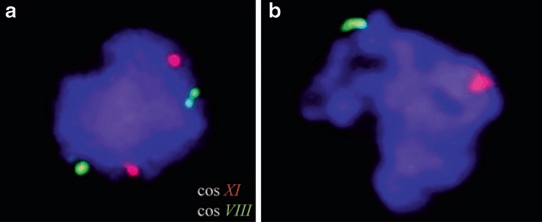Creative Bioarray provides an in situ visualization solution for the analysis of chromosomal behavior in budding yeast, helping researchers study replication-related problems in cell division. The service is designed to help customers achieve gene expression and targeted mRNA localization. With experimental platforms suitable for a variety of commercial probes and probe design customization capabilities, our FISH platform is confident to provide customers with comprehensive analysis and detection services.
Budding Yeast and Molecular Genetics Research
Fluorescence in situ hybridization (FISH) provides an efficient method to delineate chromosomes and their subregions at all stages of the cell cycle. This makes FISH particularly useful for studying chromosomal behavior in species with microgenomes and/or poor metaphase chromosome condensation, which is the case in model organisms such as the budding yeast. FISH allows one to study the location of DNA loci without the added complexity of inserting foreign non-native sequences. Because of the potential for genetic manipulation, yeast provides an attractive system for such studies. Chromosomal DNA replication is an extremely complex task. As in many other aspects of biology, the basic framework of the replication process is conserved between yeast and higher eukaryotes, including humans. The mechanism of the origin activation time program followed by DNA replication in eukaryotes is still under investigation. Research on the budding yeast has led researchers to explore how replication is orchestrated. FISH allows one to study the location of DNA loci without the added complexity of inserting foreign non-native sequences. At the same time, the potential for excellent genetic manipulation in yeast provides an attractive system for such studies. Furthermore, the number of sites that can be visualized simultaneously is only limited by the number of fluorophores available and can be differentiated by available microscopy. At the same time, FISH is also a powerful tool to study the localization of DNA sequence relationships.
 Fig 1. Some examples of studies carried out in teething yeast. (a) Spread meiocyte nucleus (DAPI, blue) hybridized with cosmids for chromosome III (green) and XI (red). (b) Same experiment but pachytene nucleus with two large signals indicating homologous pairing. (Harry Scherthan, et al. 2010)
Fig 1. Some examples of studies carried out in teething yeast. (a) Spread meiocyte nucleus (DAPI, blue) hybridized with cosmids for chromosome III (green) and XI (red). (b) Same experiment but pachytene nucleus with two large signals indicating homologous pairing. (Harry Scherthan, et al. 2010)
FISH Services for Yeast Chromosome Research
FISH with complex chromosome-wide or locus-specific probes has become an indispensable tool for analyzing chromosomal behavior in metaphase and interphase cells, especially meiotic chromosome pairings in wild-type and mutant yeast strains. One of the most fundamental aspects of meiosis is the formation of connections between homologous chromosomes. Our FISH in situ analysis protocol can help researchers perform genetic analysis in yeast meiosis, including alignment of homologous chromosomal loci. The basic process of this service includes sample preparation (cell culture and chromosome preparation), probe preparation, FISH hybridization and imaging, and data analysis. Our sample pretreatment can be described as providing technical guidance on sample preservation and preservation for customers, ensuring that samples of high quality are used for subsequent analysis steps. This service is based on custom probes, and our technology platform provides a variety of probe customization services to meet the analytical needs of researchers. Our FISH analysis solutions can also be used to analyze entire chromosomal domains, and our experts will work with you to explore many more applications.
Research Applications
Numerous studies of the origin activation time program in replication have been conducted in the model organism budding yeast.
How is the control of replication initiation linked to the various phases of the cell cycle?
How are activations of different origins coordinated across the genome?
How checkpoint monitoring systems monitor and ensure the orderly progress and completion of Phase S?
 Fig 2. FISH determination of chromosome behavior in yeast.
Fig 2. FISH determination of chromosome behavior in yeast.
If you are interested in our service, please contact us for cooperation. We look forward to cooperating with you in the near future.
Reference
- Scherthan, Harry, and Josef Loidl. "FISH as a tool to investigate chromosome behavior in budding yeast." Fluorescence in situ Hybridization (FISH). Humana Press, Totowa, NJ, 2010. 363-377.


 Fig 1. Some examples of studies carried out in teething yeast. (a) Spread meiocyte nucleus (DAPI, blue) hybridized with cosmids for chromosome III (green) and XI (red). (b) Same experiment but pachytene nucleus with two large signals indicating homologous pairing. (Harry Scherthan, et al. 2010)
Fig 1. Some examples of studies carried out in teething yeast. (a) Spread meiocyte nucleus (DAPI, blue) hybridized with cosmids for chromosome III (green) and XI (red). (b) Same experiment but pachytene nucleus with two large signals indicating homologous pairing. (Harry Scherthan, et al. 2010) Fig 2. FISH determination of chromosome behavior in yeast.
Fig 2. FISH determination of chromosome behavior in yeast.


